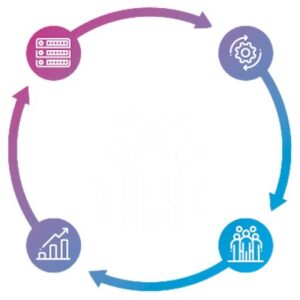Contents
- Introduction
- What is Process Simulation
- Advantages
- Historical Perspective
- Applicability to Small and Midsize Businesses
- Winning With Simulation
- Conclusion
Introduction
Process simulation has become increasingly popular in recent years as a powerful technique for modeling and analyzing complex systems. With the ability to simulate complex scenarios in a virtual environment, this approach offers several advantages over traditional business process management techniques.
In this article, we will discuss four advantages of process simulation compared to traditional business process management techniques and how small to midsize businesses can adopt and win with this powerful resource.
What is Process Simulation
 Process simulation is a method of creating a visual representation of a process or workflow through the use of simulation software. This allows businesses to model different scenarios and assess how the process will perform under different conditions. By providing a virtual mock-up of the process, simulation can help businesses to reduce financial risk by avoiding expensive real-life experiments on their businesses. Process simulation can be applied to a range of scenarios including functional staffing requirements, capacity estimation, supply chain management, service quality assessment, and manufacturing process optimization. Overall, process simulation can help businesses to optimize their workflows and improve efficiency.
Process simulation is a method of creating a visual representation of a process or workflow through the use of simulation software. This allows businesses to model different scenarios and assess how the process will perform under different conditions. By providing a virtual mock-up of the process, simulation can help businesses to reduce financial risk by avoiding expensive real-life experiments on their businesses. Process simulation can be applied to a range of scenarios including functional staffing requirements, capacity estimation, supply chain management, service quality assessment, and manufacturing process optimization. Overall, process simulation can help businesses to optimize their workflows and improve efficiency.
Advantages
1. Accurate Representation of Real-World Systems
Process simulation provides a highly accurate representation of real-world systems, including complex interactions and feedback loops that are difficult to assess using traditional process analysis techniques. By creating a virtual model of the system, process simulation allows for the modeling of complex scenarios that are difficult to recreate through experimentation or observation. This ensures that the results obtained are highly accurate and reliable, reducing the likelihood of errors in the analysis.
2. Rapid Identification of Bottlenecks and Other Challenges
Traditional process analysis techniques often require significant time and expense for data collection, analysis, and interpretation. In contrast, process simulation allows for the rapid identification of bottlenecks and other challenges in the system, enabling project managers to take corrective action before problems escalate. This, in turn, leads to improved efficiency, reduced downtime, and ultimately increased profitability.
3. Powerful Predictive Capabilities
Process simulation provides powerful predictive capabilities, enabling users to test numerous what-if scenarios in a virtual environment. This allows project managers to assess different operating conditions, changes in demand, and other key variables, helping to optimize the system and improve overall performance. By incorporating process simulation into the design phase of a project, engineers can identify potential problems earlier in the design process, reducing costs and maximizing efficiency.
4. Improved Collaboration and Communication
Process simulation enables improved collaboration and communication among different groups involved in the process, promoting a shared understanding of the system and its challenges. By using a common, virtual model, stakeholders can more easily collaborate and share information, leading to a more efficient and effective process overall.
Historical Perspective
Process simulation has been used historically in a variety of fields to model and evaluate the behavior of complex systems. Some examples of its early uses include:
- Telecommunications: Discrete event simulation (DES) is used to model complex networks, optimize performance and schedule resource.
- Aerospace: Simulation is used to model aircraft performance, reliability and control, communications, life support and other systems.
- Healthcare: Simulation has been used in healthcare to demonstrate various techniques, acquire skills, and maintain best practices.
- Chemical Industry: Simulation is used to optimize process parameters for operating chemical plants, such as oil refineries.
The use of process simulation has evolved over time, and it continues to be an important tool for modeling and analyzing complex systems in a variety of fields today.
Applicability to Small and Midsize Businesses
Process Simulation relies on a number of complex techniques including process modeling, cost analysis, statistical analysis, and data visualization. These techniques are complex and often performed by individuals with specialized education, experience and expensive tools. Because of complexity and cost, this approach has historically been outside the awareness and reach of all but large, highly capitalized businesses — with smaller businesses instead relying on traditional process analysis or gut to define and refine their business processes.
We founded Route Business Consulting because as simulation practitioners in multiple industries (aerospace, manufacturing and telecommunications) we recognize the value of these techniques and the benefits they provide to businesses of all sizes. We purposely crafted a business and operating model with the purpose of extending these capabilities to small to midsize businesses. We in-turn “ate our own dog food” and assessed, validated and fine-tuned our approach using process simulation in order to ensure that we could achieve this goal with high certainty.
Winning with Simulation
Small and midsize businesses can greatly benefit from utilizing simulation techniques to map and optimize their business processes — and in doing so gain competitive advantage against less innovative competitors.
Here are some ways that simulation can help:
- Identifying inefficiencies: simulation can help identify bottlenecks and inefficiencies in business processes, allowing for targeted optimizations that can save time and resources.
- Predicting outcomes: by simulating various scenarios and outcomes, businesses can make more informed decisions and anticipate potential problems before they arise.
- Streamlining operations: simulation can help businesses model and optimize their workflows, reducing the likelihood of errors and improving overall efficiency.
- Testing changes: simulation allows businesses to test proposed changes to business processes without impacting the actual operation, identifying areas where further adjustments may be necessary before implementing changes in the real world.
Overall, simulation allows small and midsize businesses to optimize their operations in a safe, cost-effective and efficient way, improving their competitiveness and ability to respond to changing market conditions.
Conclusion
Process simulation offers several benefits over traditional process analysis techniques. With its ability to provide an accurate representation of real-world systems, rapid identification of bottlenecks, powerful predictive capabilities, and improved collaboration and communication, process simulation is an essential tool for any business seeking to optimize the performance of their end-to-end-system. Further, with a business partner like Route Business Consulting, this powerful capability and the advantages it offers is now accessible to small and midsize businesses.
Contact us to discuss your business process challenges and how simulation can help you grow with confidence.
Technology planning, operations management, product management and marketing professional; adept at defining, directing and implementing business transformation initiatives through systems thinking, multidisciplinary problem solving, and team empowerment. Experience includes senior leadership roles within IT services, telecom, and marketing industries.
